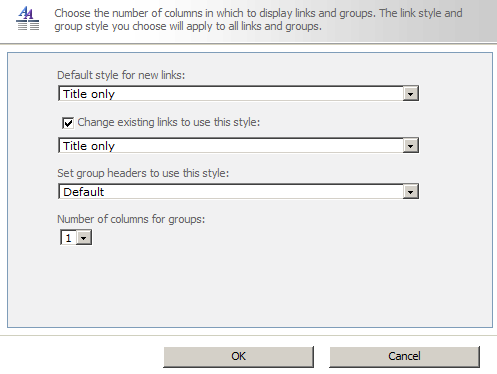Add custom styles to SummaryLinkWebPart
Add custom styles to the SummaryLinkWebPart. This technique can also be applied to the TableOfContents WebPart and the Content Query WebPart
The SummaryLinkWebPart has many styles in it, but if you need to brand it to your company’s then you can add custom styles.
Introduction to SummaryLinkWebPart
Add the webpart. It is in the category Content Rollup. See on MSDN what you can do with this webpart.


Configure styles and layout to set the layout of your style. 
Configuring SummaryLinkWebPart
Next you do an export of the webpart. In the file you can add custom links to stylesheets.
<property name="HeaderXslLink" type="string" />
<property name="MainXslLink" type="string" />
<property name="ItemXslLink" type="string" />Customizing XSL stylesheets
This stylesheets are located in the stylelibrary. Take a copy of them to see how SharePoint created this files.

The custom stylesheet can be very simple.
MyHeader.xsl
<xsl:stylesheet
version="1.0"
exclude-result-prefixes="x d ddwrt xsl msxsl"
xmlns:x="http://www.w3.org/2001/XMLSchema"
xmlns:d="http://schemas.microsoft.com/sharepoint/dsp"
xmlns:ddwrt="http://schemas.microsoft.com/WebParts/v2/DataView/runtime"
xmlns:xsl="http://www.w3.org/1999/XSL/Transform"
xmlns:msxsl="urn:schemas-microsoft-com:xslt">
<xsl:template name="CustomHeader" match="*" mode="header">
<h2>
<xsl:call-template name="OuterTemplate.GetGroupName">
<xsl:with-param name="GroupName" select="@*[name()=$Group]"/>
<xsl:with-param name="GroupType" select="$GroupType"/>
</xsl:call-template>
</h2>
</xsl:template>
</xsl:stylesheet>MyItemStyle.xsl
<xsl:stylesheet
version="1.0"
exclude-result-prefixes="x d xsl msxsl cmswrt"
xmlns:x="http://www.w3.org/2001/XMLSchema"
xmlns:d="http://schemas.microsoft.com/sharepoint/dsp"
xmlns:cmswrt="http://schemas.microsoft.com/WebParts/v3/Publishing/runtime"
xmlns:xsl="http://www.w3.org/1999/XSL/Transform" xmlns:msxsl="urn:schemas-microsoft-com:xslt">
<xsl:param name="ItemsHaveStreams">
<xsl:value-of select="'False'" />
</xsl:param>
<xsl:variable name="OnClickTargetAttribute"
select="string('javascript:this.target="_blank"')" />
<xsl:variable name="ImageWidth" />
<xsl:variable name="ImageHeight" />
<xsl:template name="MyItemStyle" match="Row[@Style='MyItemStyle']" mode="itemstyle">
<xsl:variable name="SafeLinkUrl">
<xsl:call-template name="OuterTemplate.GetSafeLink">
<xsl:with-param name="UrlColumnName" select="'LinkUrl'"/>
</xsl:call-template>
</xsl:variable>
<xsl:variable name="DisplayTitle">
<xsl:call-template name="OuterTemplate.GetTitle">
<xsl:with-param name="Title" select="@Title"/>
<xsl:with-param name="UrlColumnName" select="'LinkUrl'"/>
</xsl:call-template>
</xsl:variable>
<li>
<xsl:call-template name="OuterTemplate.CallPresenceStatusIconTemplate"/>
<a href="{$SafeLinkUrl}" title="{@LinkToolTip}">
<xsl:if test="$ItemsHaveStreams = 'True'">
<xsl:attribute name="onclick">
<xsl:value-of select="@OnClickForWebRendering"/>
</xsl:attribute>
</xsl:if>
<xsl:if test="$ItemsHaveStreams != 'True' and @OpenInNewWindow = 'True'">
<xsl:attribute name="onclick">
<xsl:value-of disable-output-escaping="yes" select="$OnClickTargetAttribute"/>
</xsl:attribute>
</xsl:if>
<xsl:value-of select="$DisplayTitle"/>
</a>
</li>
</xsl:template>
</xsl:stylesheet>Create webpart file
Next we upload the custom styles and make a reference to the custom stylesheet in the webpart file.
<property name="HeaderXslLink" type="string">/Style%20Library/XSL%20Style%20Sheets/MyHeader.xsl</property>
<property name="MainXslLink" type="string">/Style%20Library/XSL%20Style%20Sheets/MySummaryLinkMain.xsl</property>
<property name="ItemXslLink" type="string" >/Style%20Library/XSL%20Style%20Sheets/MyItemStyle.xsl</property>Choosing the styles in the SummaryLinkWebPart now looks like this. Only the style configured in the custom stylesheets are shown in the option list.

Summary
This way of styling can also be applied to TableOfContents WebPart and Content Query WebPart. First time you do this it can look complicated but it is not.